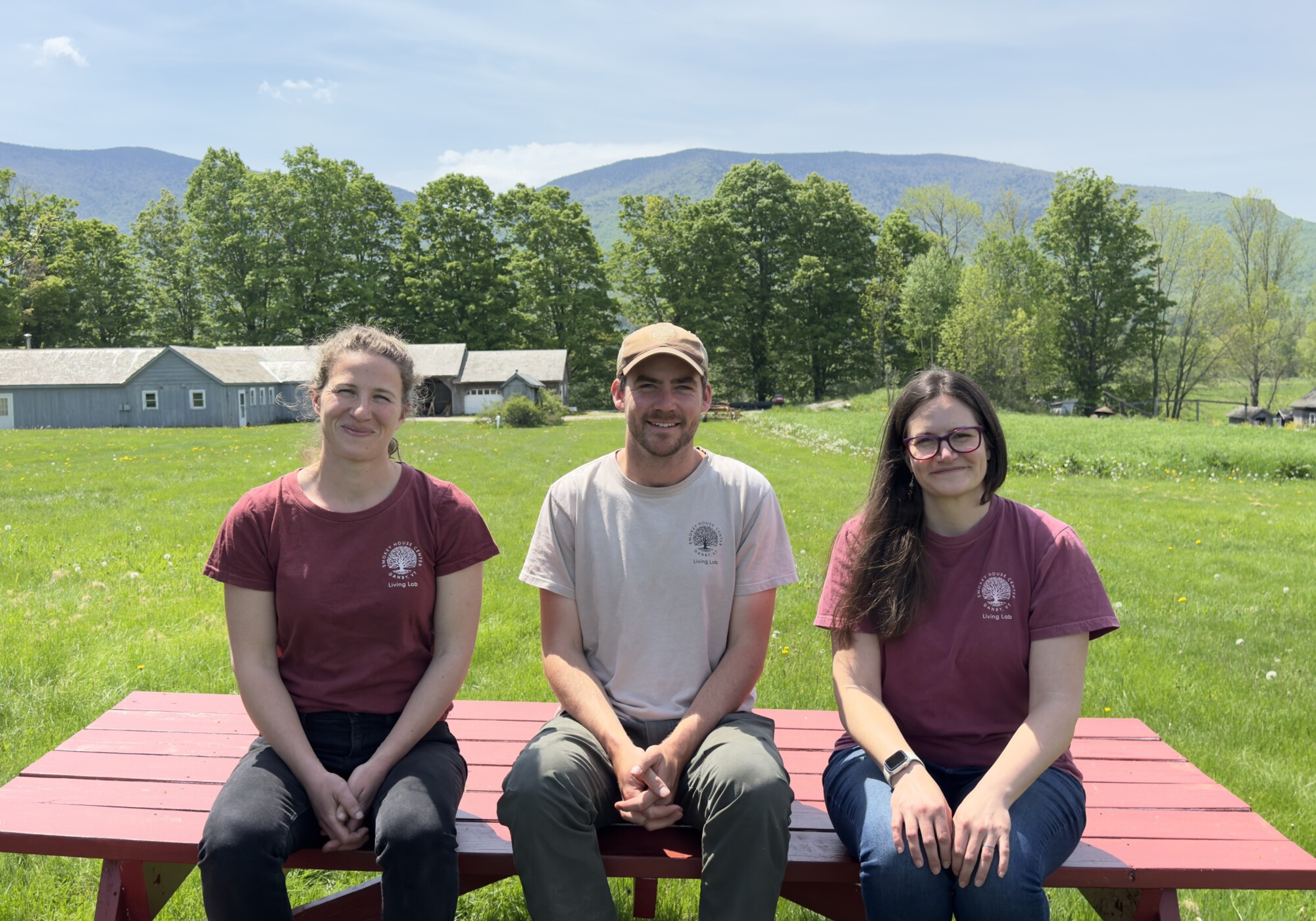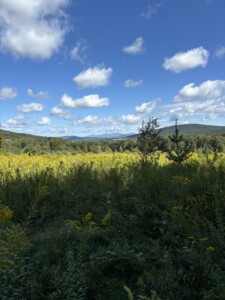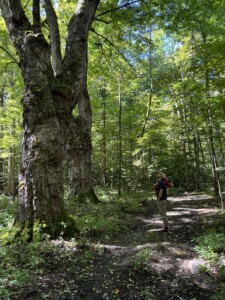Vermont’s Smokey House Center Offers a “Living Laboratory” for Fields, Forests and Climate Change
August 11, 2025


Smokey House Center encompasses 4,000-acres of forestland and 1,000-acres of working farmland that are part of a “living laboratory” exploring farming and forestry in the context of climate change. Photo by Emily Bradbury.
Can local wood help solve affordable housing? How will Vermont’s sugar maples adapt to climate change? Could cultivating crops like ginseng and ramps in the forest improve economic resilience for farmers?
These are among the questions being investigated at Smokey House Center, a 5,000-acre “living laboratory” in Southern Vermont committed to exploring ecologically sound farming and forestry practices in the face of climate change.
“We have unique resources here and can model solutions in our corner of the world that might help other people in their corner of the world,” said Walker Cammack, program director at Smokey House. “What would it look like for humans to be ecosystem engineers that are seeding abundance and healing, not extracting resources at the expense of other living things?”
Among those “unique resources” are 4,000-acres of forestland, 1,000-acres of working farmland, a legacy of engaging youth, and a stunning location tucked into the convergence of the Green and Taconic mountain ranges. Established in 1974 as a place to train youth for jobs in farming and forestry, the board of directors established a three-person shared leadership team in July 2024 to reimagine the Center’s future. Cammack, the program director, along with Mara Hearst, finance and administration director, and Danielle Zimmerman, development and communications director, are co-leading Smokey House into its next chapter.
Rooted in the past, Smokey House looks to the future
“Since the beginning Smokey House has been about teaching through place,” said Cammack. “Originally, it was a place for young people, often high schoolers looking for ways to thrive outside of the traditional classroom setting, to gain practical career-building skills in farming, forestry, and the likes. Today, we’re trying to do the same thing, but specifically training young people in the skills that can help our human communities and the ecosystems we rely on persist and thrive in the face of climate change.”
As in the early days, programming at Smokey House Center remains grounded in practice. The partner farms on the property are real, for-profit farms. The interns who spent the summer inventorying forest stock are contributing to cutting-edge research at the country’s top environmental institutions, including Yale School of the Environment and UVM’s Rubenstein School of Environment and Natural Resources. Some of the students who visit from nearby public schools come from families whose livelihoods have depended on the land to make a living for generations.
“It feels like people are ready to embrace new ideas,” said Cammack. “This is a place to bring together traditionally siloed groups–academics, scientists, farmers, foresters, young people, and indigenous people who have been left out of decision-making–to envision the future we want and start training people to bring solutions out into the world.”
Piloting a local model of affordable housing
A new housing model being developed on-site offers one example of the collaborative, forward-thinking solutions Smokey House Center hopes to advance. “After COVID, we saw this huge influx of people buying land and homes in Vermont,” said Cammack. “It put a lot of pressure on the affordable housing market. And then, we have this kind of broken system where local wood is being sent out of state while we’re importing lumber for new construction.”
Through a grant from the Northern Border Regional Commission, Smokey House is piloting a new model of affordable housing using local materials. In the spirit of their practical nature, the model will serve as housing for the Center’s interns and visiting researchers, and eventually expand to provide housing for farm workers.
The idea, says Cammack, is to prove the model, identify barriers, and provide builders with the knowledge and training they need to use local materials. The project is being undertaken in partnership with the UVM Rubenstein School, the Parsons School of Design Healthy Materials Lab, the Vermont Green Building Network, the Vermont Sustainable Jobs Fund, and New Frameworks, a worker-owned construction company based in Essex Junction, Vermont.
“A theme of what we’re doing here, in the face of climate change, is how do we build more place-based economies that are resilient, sustainable and independent?” said Cammack. “Just getting all these partners in the same room to talk about how that happens in the context of affordable housing is really inspiring.”
Cammack expects the model, along with a local materials guide, to be completed in 2026.
Forest farming for resilience
Smokey House Center is also actively engaged in understanding how forest farming might help landowners diversify income streams and improve resilience to climate events, like last summer’s floods. Ginseng, edible ramps, and medicinal plants such as black cohosh, bloodroot, and Solomon’s seal are among the species the Center is currently cultivating. “There are existing, oftentimes global markets for many of them,” said Cammack. “And they are all native to this region, so there’s a restorative benefit to the forest understory as well.”
He’s quick to add that forest farming is not something that would replace conventional agriculture or timber harvesting. Rather, he says, it’s another option that could improve economic resilience. “It might just be a little extra income that helps pay for property taxes,” he said. “Or, if flooding devastates a crop one year, maybe that’s the year the farmer harvests the ginseng.”
The Center hosted the Northeast Forest Farmers Coalition conference last summer, which has grown to more than 800 members in three years. The conference sold out and had a waiting list with dozens more. “It sort of feels like a movement,” said Cammack. “So, our goal is to build as big a tent as possible and figure out how to do this.”
Maple production in a changing climate

Forest programs at Smokey House include harvesting local wood for affordable housing, cultivating forest crops, and researching the impact of climate change on Vermont’s maple industry. Photo by Emily Bradbury.
Perhaps the most famous of Vermont’s “forest crops,” Smokey House Center is conducting research on how Vermont’s beloved and iconic maple trees might be impacted by climate change. According to the USDA, Vermont’s maple production was valued at $84.5 million in 2022. Vermont is the largest producer of maple syrup in the U.S., and has been since 1916.
“It’s a huge industry,” said Cammack, “and a very relevant industry to think about in terms of susceptibility to climate change.”
The 4,000 acres of forest on the property has a long history of maple syrup production. Cammack estimates that there have been 15 to 20 sap operations on the land over time. Today, Smokey House Center has about 2,000 taps–a relatively small number in comparison to larger producers in Vermont who may have ten times that number.
The Center is undertaking a two-part research initiative. First, are there climate adaptive forest management strategies that can be applied to help set a sugarbush up for success? And, second, how does tapping a tree year after year affect its resilience?
“We know sugar maples don’t do well in drought,” said Cammack, whose background is in forestry. “There are certain invasive pests that can lead to major defoliation events. And, it’s an industry that has historically incentivized monoculture over diversity of species and structure, which makes it particularly vulnerable.”
The study began last summer with a group of interns who began an inventory of the property’s maple stock. The Center will establish two sugarbushes for comparison studies on production, tree health, and overall forest resilience.
A sense of place
The Center’s lofty ambitions are very much rooted in place, says Cammack. “Vermont lends itself well to early adopters,” said Cammack. “Along with our history with fields and forests, and the culture of being a neighborly place where people are willing to work across divides, the idea is that we can discover and model solutions that can be replicated elsewhere.”
Although Cammack hesitates to use words like “hope” and “magic,” they slip out when he talks about the relevance and importance of places like Smokey House Center in the world today.
“So many young people feel hopeless about the future,” he said. “Here, they can feel empowered and be part of implementing solutions. We are conducting hard, scientific research and really investigating what future practices will look like, but we’re also talking about human connection to nature, about how to create abundance that is not at the expense of other living things around us. We are just one species and this place…we don’t have to work hard for people to feel that. It’s kind of magical.”
About the Vermont Forest Products Program
Vermont’s forest economy contributes more than $2 billion in direct economic output and provides more than 13,000 jobs in forestry, logging, processing, specialty woodworking, construction, wood heating, maple production, and forest-based recreation. The Forest Products Development Program at the Vermont Sustainable Jobs Fund (VSJF) creates space for strong relationships and collaboration throughout the industry and promotes the development of new and existing markets for Vermont wood products.
Read More Stories Like This:
- Forest Business Accelerator announces 2025 cohort of innovative wood and forest product startups
- Scratch Builders Goes Out on a Limb
- Reimagining a forest products industry that solves problems for people and planet
- Business Sense – FREE training series for entrepreneurs and small business owners
- Rockledge Farm Woodworks: A Father-Son Furniture Making Business Navigates Growth, Transition
- Sawyer Made Balances Growth with Tradition




